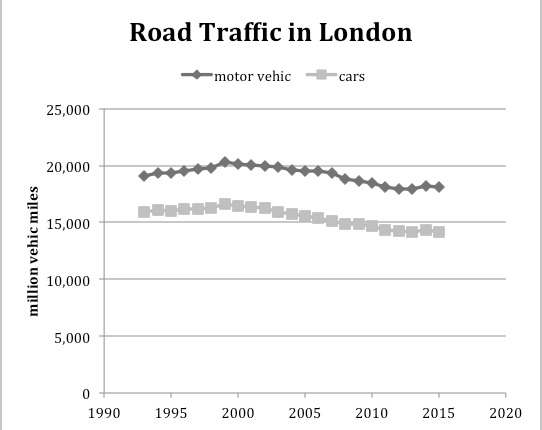I have a new book published on 1 September, one in a series of short books on policy and economics topics described as ‘essays on big ideas by leading writers’. My contribution is a critique of the inconsistencies of transport policy in recent decades, which I attribute to the shortcomings of conventional transport economic appraisal in identifying the benefits that arise from investment.
The Transport Committee of the London Assembly is holding an inquiry into growing traffic congestion in London. The evidence I submitted is below.
Introduction
Although London’s population has been growing quite rapidly, road traffic in London has not increased over the past two decades, both cars and all motor vehicles, as Department for Transport statistics show (see Figure).
Road traffic growth has been inhibited by the retention of London’s historic street pattern, more road space allocated to buses, cycles and pedestrians, controls on parking in inner boroughs, and congestion charging. The public has accepted constraints on road traffic growth because of investment in public transport, particularly rail, which generally provides speedy and reliable travel for commuting and for work-related journeys in central London. As the population has grown, car use, as a share of all trips, has declined from a peak of 50% in 1990 to 36% currently, projected to decline to perhaps 27% by mid-century with continuation of present policies.
Mitigation of Traffic Congestion
Average travel time is invariant as measured in the National Travel Survey: over the past 40 years, it has remained steady at about an hour a day nationally, 1.1 hours in London. Accordingly, traffic congestion is self-limiting: as traffic speeds fall, journey times rise, and flexible road users change the timing, mode or destination of their trips. Gridlock can generally be avoided through Active Traffic Management measures.
The origin of the recent observed increase in congestion is unclear: it could be a short-term response to particular developments, such as the Cycle Superhighways or the construction boom, with congestion expected to lessen in time as the more flexible road users adjust.
Of the of possible means for mitigating congestion:
- Investment in rail to accelerate mode shift is likely to have the biggest impact.
- Flexible road users could be encouraged to avoid peak congestion by providing them with good information on expected journey times via mobile phone apps. This would reduce congestion for those whole are less flexible.
- A workplace parking levy might be beneficial, particularly by generating funds to support investment in public transport.
- More bus priority measures, including Bus Rapid Transit, would increase the speed and reliability of buses, thus attracting people from cars.
- It would be worth investigating the scope for fine-tuning road layouts, on-road parking restrictions, permitted turns and Active Traffic Management, based on suitable traffic modelling methodologies.
- Car sharing in place of personal ownership results in people making less use of the car, which is helpful.
Other possible means for mitigating congestion seem less attractive:
- The extension of congestion charging to the Western zone in 2007 and its subsequent withdrawal in 2011 had little impact on congestion. A substantial increase in the charge would pose problems of public acceptability.
- New road infrastructure, such as the proposed East London River Crossings, would add to traffic without reducing overall congestion. We know from experience that we can’t build our way out of congestion (and understand why).
- Regrettably, investment in cycling infrastructure is unlikely to get people out of their cars. In Copenhagen, 30% of all trips are by bike, but car use at 33% is only a little less than London: walking and public transport take the hit. However, investment in cycling infrastructure would reduce crowding on public transport. (Relevant to Q4,14)
- Driverless cars, as being developed by Google for instance, are essentially taxis with robot drivers. More use would be made of such taxis if they were cheaper, as they might be if robots replaced human drivers, which would increase demand. Parking requirements for privately owned cars might reduce in residential districts and in off-street car parks, but not for on-street parking in central areas, so the impact on congestion seems unlikely to be substantial.
Increased vehicle occupancy
One longer term approach to mitigating congestion would be to encourage increased vehicle occupancy. For instance, UberPOOL offers ride sharing for people going in the same direction, sharing the cost. In the long run we might envisage a system of driverless shared-occupancy taxis. This could be facilitated by (a) demand management measures to prioritise shared over single occupancy (as High Occupancy Vehicle lanes on US freeways or the exemption of taxis from congestion charging in London); and (b) traffic management that takes advantage of developing vehicle-to-infrastructure communications to smooth flows and avoid conflicts (analogous to Air Traffic Control). While implementing a system of this kind would face formidable challenges – technological, institutional, commercial, public acceptability – it offers the prospect of a more efficient road network that provides reliable, uncongested, door-to-door travel at the user’s time of choice.
Conclusions
Traffic levels in London as a whole are stable, despite population growth. Congestion is self-limiting, as flexible road users adjust to slower speeds. There is scope for accelerating the shift away from car use, without detracting from London’s success, particularly by further investment in public transport, which could ease traffic congestion. In the long run, driverless shared-occupancy taxis may allow a significance increase in efficiency of the road network.

